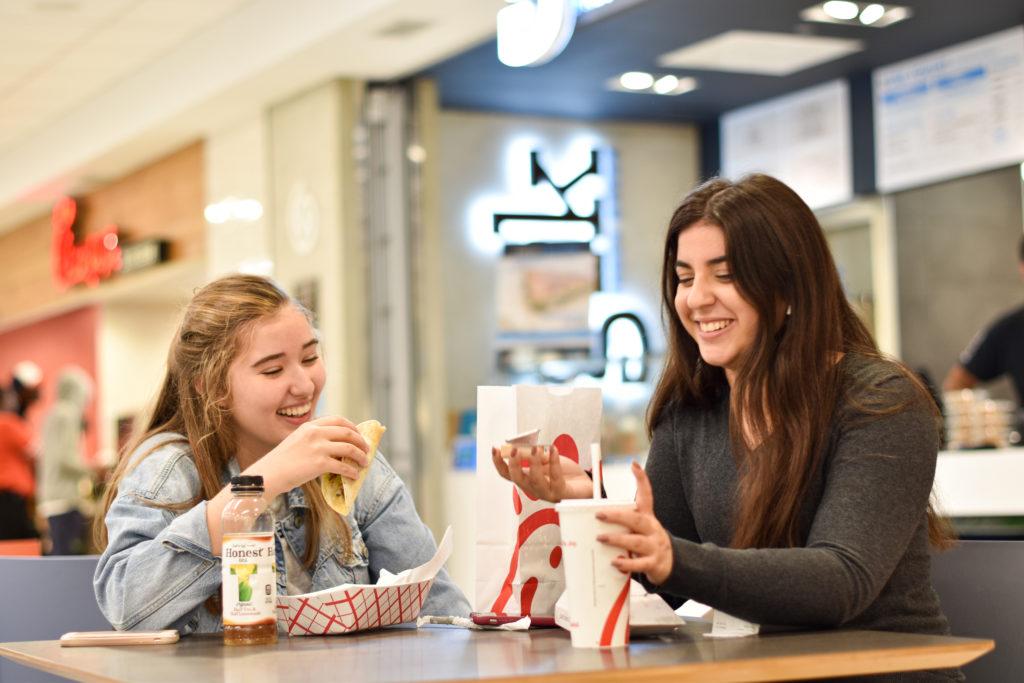After a year’s worth of discussions, officials are piecing together plans to improve campus dining by the end of the semester.
University spokeswoman Crystal Nosal said officials formed a committee at the start of the academic year to discuss potential dining changes, like adding dining options to Thurston Hall when renovations to the building are complete, and will present recommendations to “stakeholders” later this semester. Committee members are using a survey disseminated earlier this year, which asked where students typically eat and how much they spend on each meal, to determine appropriate changes to the dining program, she said.
“Since GW’s dining offerings have evolved over the years, the University is taking a look at campus dining and how it can be more integrated into the student experience and help foster a sense of community on campus,” Nosal said in an email.
She said officials held focus groups for students in October to share their dining experiences with administrators, and the committee is still reviewing students’ responses from both the groups and the dining survey. Nosal added that the committee typically meets each month but held more frequent meetings in October when the survey and focus groups occurred.
Nosal said representatives from the Division of Student Affairs and the Executive Vice President and Chief Financial Officer Mark Diaz serve on the committee. She said officials are holding conversations about the food service slated to be included in the Thurston Hall renovations.
“What that food offering will look like within the building, such as the vendor or the look and feel of the space, is still under discussion,” she said.
Student Association President SJ Matthews said she served on the committee to discuss potential dining changes, like adding a dining hall to Thurston and transitioning GWorld options to a tier system under which students can choose their price bracket for food.
She said officials are planning to include an “all you care to eat” dining hall in Thurston, but she would like the University to consider constructing an additional dining hall. Matthews said she and officials are in conversations about the best location to place a potential second dining hall.
Student leaders recommended in April that officials add a dining hall to the Foggy Bottom Campus to combat food insecurity. The suggestion came out of a year-long task force that looked into ways the University can improve campus dining.
“I think students want it,” Matthews said. “And I think it would be nice to have that community building aspect.”
The Foggy Bottom Campus’ former dining hall J Street shuttered in 2016 when the University switched to an open dining plan. A number of food vendors and a student-run food pantry began operating in the basement of District House after the hall opened in 2016.
Matthews said officials should consider student feedback when making the final decision about whether to add the second dining hall.
“Getting food is one of those things you shouldn’t have to worry about,” Matthews said. “College is already stressful enough.”
Residence Hall Association President Trinity Diaz said officials are still figuring out the “logistics” of a “dining experience” in the Thurston renovation plans.
“A lot of the feedback I hear from students is they’d love to have a dining hall and it’s the one thing missing for them,” she said. “They’d love to have a good variety of food, they don’t want just a pizza bar and fried food. They want to make sure that there are healthy options in there.”
In interviews, more than 20 students said proposed plans to add a dining hall to the Foggy Bottom Campus would help them find a centralized place to eat and socialize.
Elizabeth Benjamin, a freshman and Thurston resident, said she typically purchases food from Whole Foods and prepares meals using the microwave in her residence hall room, but buying healthy foods can be expensive.
She said the cheaper options closer to Thurston, like Carvings and 7-Eleven, are not as healthy as vendors like Whole Foods on the opposite end of campus.
“In general, I feel like for most places you go to, something that you get is going to be like at least $10, which is kind of annoying,” she said. “I would say that cheaper food is definitely less healthy for you.”
Anna Adler, a freshman and Thurston Hall resident, said officials should prioritize adding dining options to the edges of campus, where most freshmen live.
SA Sen. Howard Brookins, U-at-Large and a candidate for Student Association president, said he wants officials to establish a student-run food cooperative near F Street, which is farthest from the on-campus grocery Whole Foods.
Adler said a dining hall will give students affordable food options and increase variety in student diets.
“I’d also hope they would put it in a central location that is accessible for all students on campus,” she said.
Sophie Spiro, a freshman and Potomac House resident, said the current dining plan is unfair to students who can’t afford to add more money to their GWorlds. Spiro said adding a dining hall with affordable options would help students who struggle to afford meals from GWorld vendors.
“I do think having a dining hall would help build a sense of community among the student body because we would feel more equal and less divided according to financial status and factors like that,” Spiro said.





